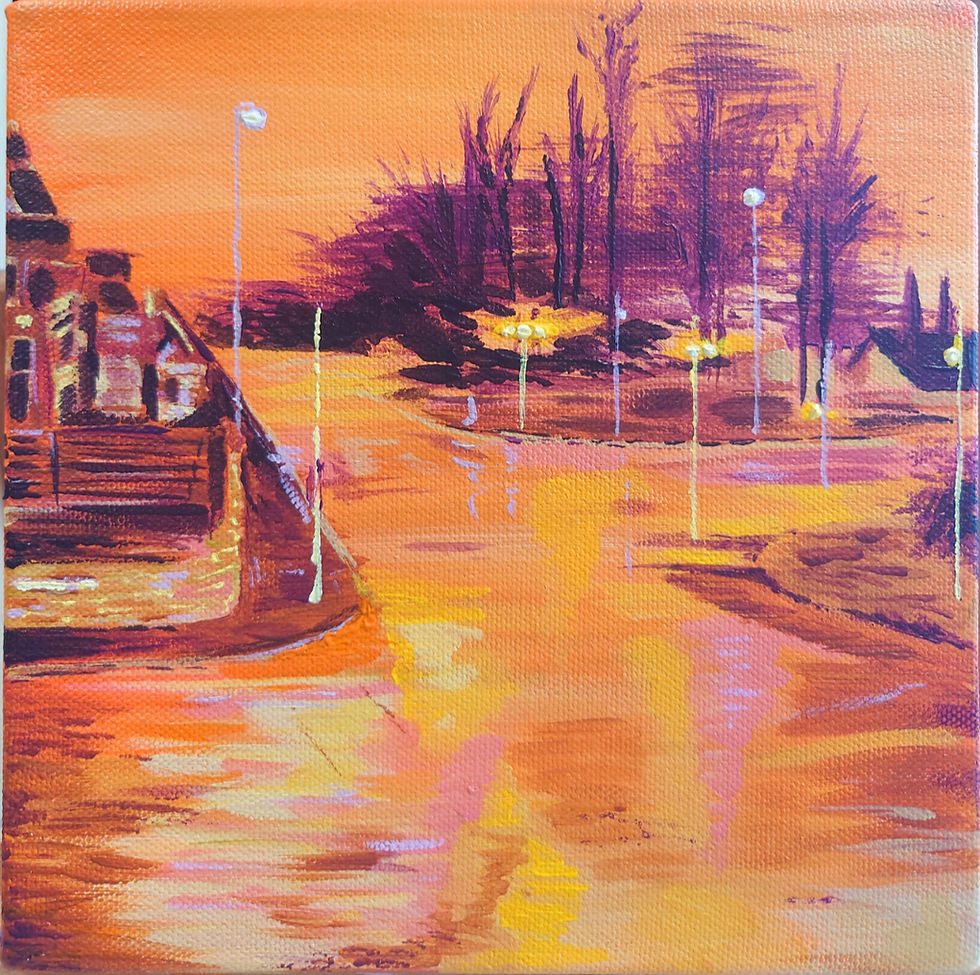From Blank Canvas to Cityscape: Bringing Urban Shuck to Life
- Hannah Kate

- Aug 22
- 4 min read
While discussing ideas with my client for their Black Shuck commissioned piece, the spark of an idea flashed into my imagination for a more modern rendering of the infamous spectral dog.
One option that had briefly been on the table was an illustrative painting of a more recent encounter with a Black Dog in Cambridge.
One evening in the summer of 1970, a husband and wife were driving along an unlit road when a huge black dog leapt across the bonnet of their vintage-style car, disappearing into the allotment beside the road.
The couple stopped the vehicle and searched the area but found nothing. Both reported that they felt cold as the creature jumped over the car and their own dog, sitting on the back seat, was described as showing “abject terror” at the “wolf-like animal”.
They were convinced they had seen Black Shuck.
Not long after this happened, they experienced a serious financial loss and within two years the husband had fallen ill and passed away at a young age.
Although my client and I ultimately chose to create a more traditionally styled Shuck, we did explore the above tale as a source of inspiration. I followed the geographical breadcrumbs left in the article and, by the wonder of a map-based app, was able to conjure current street views of the possible area and spent time picturing how the hellish hound may have looked in street-lit surroundings rather than his traditional churchyard.
These ideas were left to percolate while I worked on the commissioned piece, and my subconscious turned them into something new again.
The idea for the Urban Shuck was born.
Read on to follow his journey from blank canvas to life in his very own cityscape...

I began with a fresh, chunky-edged stretched cotton canvas. I enjoy painting on these deeper frames as it allows me to wrap my colours around the sides of the painting and extend the peripheries of my image in a new direction.
I decided to treat this canvas as a bit of an experiment as I couldn’t see how I'd like the final piece to look. Usually I have an almost fully formed image in my mind's eye that I work towards, but this time I would just play and see where the brushes took me.
I also don't usually cover the white gesso with such a bright, hot swathe of neon.
Not very Goth of me.
But I had a much warmer colour palette in mind for this piece than I would usually use and the hot base colours would help bring the warmth through.
These next two images are a great example of how much difference the lighting makes when I take photos of my work. Same canvas, but the different light levels make the colours look washed out in the second image.
You can see I had started to make some initial marks for reflections and structures that would be added later.
I see trees of... purple?
Ok, so it doesn't quite fit the song, but I was enjoying myself!
Here's my attempt at a much looser style than usual, abandoning my usual attention to every detail. (I was sure they would sneak back in later but wanted to go with the flow for as long as I could.)
You can see more of the background being added, along with some more definite buildings in the mid-ground.
Below you can see the state of my palette and the painting (so far)!
The composition was beginning to take shape - not quite how I first envisioned it but I was on a bit of a magical mystery ride with this one. The perspective was definitely a bit skew too, so that needed fixing with more work.

A few days later and I'd made some adjustments.
I was still trying to stick to a much looser style than usual although by this point, I’d let a few details begin to sneak as I neared completion.
You can see the gentle reflections of the newly added streetlights on the wet road.
I really didn’t like those buildings on the left, so knew I would need to change them, then I could focus on the Shuck.

The star of the show has entered the building!
Our Shuck has appeared on the road, its huge form looking slightly out of place and scale.
Legends gave descriptions of Black Shuck measuring seven feet tall and I spent more time than was probably strictly necessary figuring out how big that would make him against a pelican crossing box on a lamp post!
At this stage I softened the reflections and colours to the front left of the canvas and reduced the height of the buildings on the left-hand side. You can also spy a new group of vehicles on the road in the distance, headlights adding to the ripples and fractures in the light.
There were just a few more additions and changes to be made before the painting would be complete.

Finito!
I tidied up his eyes a little and fixed those cursed buildings on the left.
This palette grew on me more and more as I painted and it helped me step out of my usual colour comfort zone.
I'm still enjoying the moodiness of the background and rain-soaked road before our spectral hound's feet.
Urban Shuck has now been varnished, and I’ve added fixings to the reverse so he's ready to hang.

Looking back, each layer of paint became a negotiation between detail and atmosphere as I tried to keep a looser style. This helped me to create harmony between the mythical and the everyday life of the street.
Shuck’s presence seemed to distort perspective and the play of light and shadow within the scene and the cityscape appears to pause expectantly.
Although the painting is now complete and ready to hang, I hope that the story it tells will endure: a spectral guardian wandering rain-slicked streets, caught somewhere between history and imagination.
Find more information about the Urban Shuck painting here.
You can read the original article detailing the 1970 Black Shuck incident here: Shuckland: Hidden East Anglia






















Comments